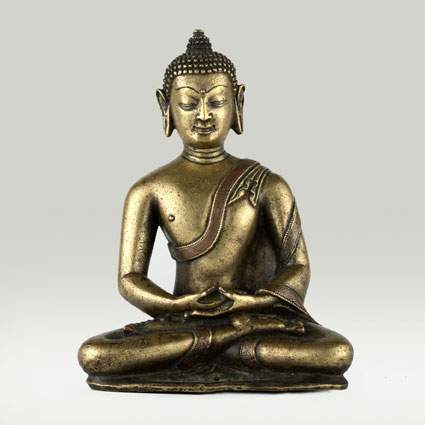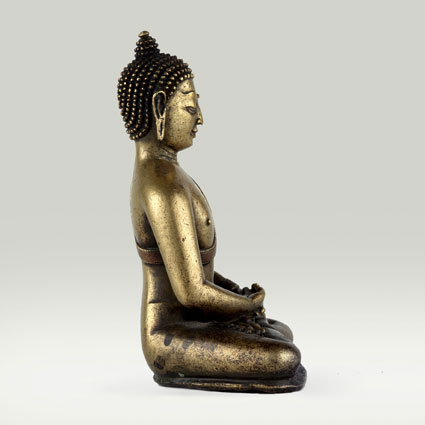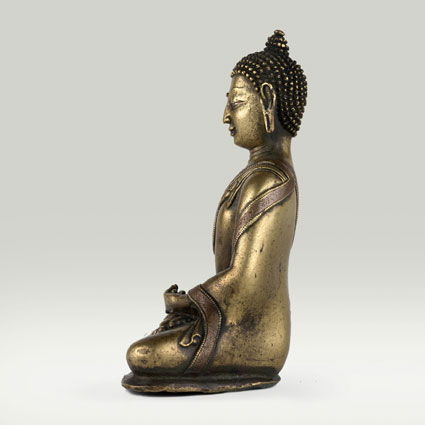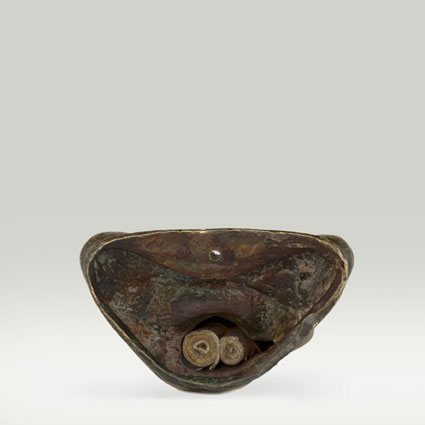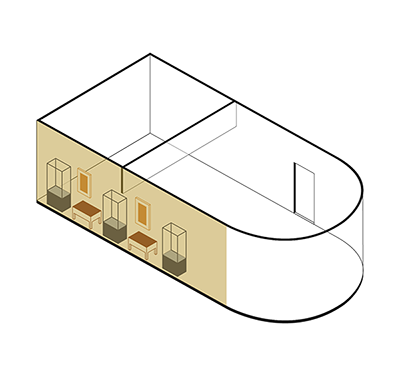ABS 116
Code: ABS 116
Country: Tibet
Style: Late Pala Style
Date: 1200 - 1300
Dimensions in cm WxHxD: 7.8 x 10.5 x 4.9
Materials: Brass
Buddha Shakyamuni
Hollow cast in one piece. The separately cast pedestal is lost.
Silver and copper inlays highlight the eyes, the third eye (urna), as well as the finger- and toenails. The hem of the monk's robe is also inlaid with silver and copper and decorated with engraved ornaments. The edge of the lower robe (antaravasaka) is visible.
The tradition of silver copper inlay works entered Tibet from North-East India, Kashmir and Himachal Pradesh. The Pala-related style elements are an indication that this image was probably cast in Central Tibet during the 13th century. Inlay work of such fine quality is rare.
The Buddha is seated in the diamond attitude (vajraparyankasana). He rests his left hand in his lap and extends the right hand in the gesture of touching the earth (bhumisparsha-mudra). With this gesture, the historical Buddha Shakyamuni “takes the earth as a witness” of his victory over his inner demons of doubt, the mara.
The upper monastic garment (uttarasanga) covers only the left shoulder and is draped without folds. This depiction of the historical Buddha reminds us also of the place of his awakening (enlightenment). Bodhgaya in northern India subsequently became the destination of Buddhist pilgrimages to the "eight holy places" (astamahasthana).
Hollow cast in one piece. The separately cast pedestal is lost.
Silver and copper inlays highlight the eyes, the third eye (urna), as well as the finger- and toenails. The hem of the monk's robe is also inlaid with silver and copper and decorated with engraved ornaments. The edge of the lower robe (antaravasaka) is visible.
The tradition of silver copper inlay works entered Tibet from North-East India, Kashmir and Himachal Pradesh. The Pala-related style elements are an indication that this image was probably cast in Central Tibet during the 13th century. Inlay work of such fine quality is rare.
The Buddha is seated in the diamond attitude (vajraparyankasana). He rests his left hand in his lap and extends the right hand in the gesture of touching the earth (bhumisparsha-mudra). With this gesture, the historical Buddha Shakyamuni “takes the earth as a witness” of his victory over his inner demons of doubt, the mara.
The upper monastic garment (uttarasanga) covers only the left shoulder and is draped without folds. This depiction of the historical Buddha reminds us also of the place of his awakening (enlightenment). Bodhgaya in northern India subsequently became the destination of Buddhist pilgrimages to the "eight holy places" (astamahasthana).

